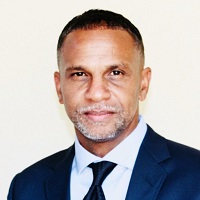Home > Columns > Executive Interviews
Vonage Executive Interview

Reggie Scales, Global Head of Applications, Vonage
Click image below to view the ebook

In this discussion, Sheri Greenhaus, Managing Partner,
CrmXchange, and Reggie Scales, Global Head of Applications, Vonage, explore how
Vonage is transforming customer communications by integrating UC, CC, and AI
into a seamless, all-in-one platform. Reggie shares insights on the company’s
evolving strategy, the role of AI in enhancing customer experience, and how businesses
can simplify their tech stack with an "easy button" approach. We’ll
cover everything from implementation timelines to key decision-makers driving
adoption.
Sheri Greenhaus: What
topics are you focusing on at 2025 Enterprise Connect?
Reggie Scales: Our
primary focus is on the contact center and AI—that’s the direction we’re headed
as a business. While we’re bringing all communication channels together into a
single platform called Fusion, we’re not ignoring UC use cases.
Fusion is our AI-powered contact center solution that
integrates UC, CC, and AI into a single-vendor offering. Vonage has
historically been known for its contact center solutions, primarily within
Salesforce. However, we’ve expanded that with our Intelligent Workspace
offering, providing a full omnichannel CC solution both inside and outside of
Salesforce. This integrates UC, CC, and AI into a cohesive experience.
We’re also making moves in UC, even though the space is
increasingly commoditized with hyperscalers dominating.
We’re seeing more companies make UC and CC decisions
together, with the same teams managing both. By offering a single, integrated
platform, we’re ensuring that contact center employees and other business users
have the connectivity and tools they need.
Sheri Greenhaus: Technology
is supposed to make things easier for customers, yet many still complain about
poor experiences. They start with chat on a website, don’t get the answers they
need, and then call a company—only to start their issue from scratch. Some
businesses still don’t have unified systems, leading to frustration. With all
the technology available, why is this still happening?
Reggie Scales: The
industry hasn’t simplified customer engagement enough. There are too many
disconnected channels, making it harder than it should be for customers to get
help. That’s exactly why we’ve adopted a one-platform approach.
Instead of forcing businesses to define separate UC, CC, or
AI experiences, we’re building an intelligent, unified platform—Fusion—that
brings everything together. It’s an AI-powered omnichannel contact center
solution designed to eliminate silos, reduce friction, and create a seamless
experience for both businesses and their customers.
We’re evangelizing the future, but we also recognize that
the narrative needs to be simplified. That’s our goal—making it easier for
companies to deliver seamless, intelligent customer interactions across every
touchpoint.
Sheri Greenhaus: When
you talk about Fusion, are companies looking to rip and replace, or can it be
layered onto existing systems? How does that work?
Reggie Scales: It
depends on where they are in their journey. The highest adoption comes from
companies that have already migrated from on-prem to the cloud.
Once they’re in the cloud, many find themselves juggling
multiple vendors. We offer a one-vendor approach that consolidates their
communications. It’s not necessarily a full lift-and-shift; rather, it’s a
migration that depends on their specific needs.
To give an example, a national leader in the construction
services industry needed a unified communications and contact center solution
to support multiple locations and thousands of employees. Previously, they used
one vendor for UC and another for CC. They wanted a single platform to
streamline communications, enhance customer service, and transition away from
third-party data centers.
We became that integrated solution, providing UC and CC on
one platform. This connected their workforce, improved service levels,
future-proofed their infrastructure, and delivered cost savings along the way.
Sheri Greenhaus: What
led them to make the decision to migrate?
Reggie Scales: A
few factors played a role. Their journey to the cloud started before working
with us—they initially went with a competitor for UC while also implementing
Salesforce. As they became more comfortable with their CRM, they saw
opportunities to capture better data, improve interactions, and enhance
customer engagement.
This led them to reconsider their UC provider. They wanted a
unified platform that fully integrated with their CRM and provided better
insights. That’s where we come in. We helped them transition from their
existing cloud communications setup to a single-vendor solution that met their
long-term goals.
Sheri Greenhaus: Beyond
the transition costs, are companies seeing long-term cost savings?
Reggie Scales: Absolutely.
While their primary goal was to move to the cloud for efficiency, cost savings
became a significant added benefit. It wasn’t just about reducing expenses—it
was about streamlining operations, improving customer service, and increasing
flexibility. Moving away from on-prem infrastructure and third-party data
centers helped them achieve all of that.
Sheri Greenhaus: For
companies already in the cloud, is it easier for them to evaluate providers and
make a switch compared to those still managing proprietary in-house systems?
Reggie Scales: Yes,
and we’re seeing that trend accelerate. Companies that have already adopted the
cloud are more likely to consolidate their solutions and look for better
integration. Once they take that first step, they quickly recognize areas where
they can improve further.
That said, we’re still working with companies transitioning
from on-prem, and we see hybrid environments as well. But the majority of our
business comes from cloud adopters. The shift to remote work, especially
post-COVID, has significantly driven cloud adoption and digital transformation.
Sheri Greenhaus: Initially,
everyone was working remotely, but now we’re seeing more employees return to
the office. When we do webinars, we always ask if attendees' workforces are
on-prem, remote, or hybrid, and more companies seem to be bringing employees
back. Are you seeing that trend as well?
Reggie Scales: Yes,
we are. It’s been interesting to watch it play out. After the pandemic,
companies debated whether to stay fully remote or return to the office. Some
worried about a drop in productivity, but many found that remote work actually
improved efficiency by eliminating commute time and distractions.
Now, we’re seeing a shift back to the office for cultural
reasons—companies want employees to collaborate in person, build stronger team
connections, and maintain a sense of community. At the same time, technology is
enabling hybrid models that support both remote and on-prem work. The key is
providing flexibility while keeping employees connected, no matter where they
are.
Sheri Greenhaus: We’re
seeing a lot of hybrid models, with employees wanting to be in the office at
least part of the time. Sometimes, it’s just to talk through a challenge or
connect with colleagues. It’s not necessarily about being there every day, but
people seem to be missing that social interaction.
Reggie Scales: That’s
a great point. It’s a balancing act, and it’s evolving. The good thing is that
technology now gives businesses the flexibility to support both models
effectively. Customer experience is at the heart of everything we’re working to
improve. We’re looking at solutions through the eyes of the customer, ensuring
that what we build makes their experience as seamless as possible.
In my new role, my focus is on creating the "easy
button" for our customers—simplifying the way they procure services,
streamlining onboarding, and making account management effortless. Our goal is
to package everything into a single platform that integrates UC, CC, and AI.
Everyone talks about being frictionless and seamless, but
we’re actively building that experience. By consolidating everything into one
intelligent platform, we eliminate finger-pointing between vendors. Adding
mobile capabilities takes it even further, ensuring that we support customers
all the way through the last mile of connectivity.
Sheri Greenhaus: If
a company is ready to move forward, what does the setup process look like? How
long does it take to be fully operational?
Reggie Scales: It
depends on the size of the business:
- Micro and small businesses (under 10 seats): Everything is automated, and we can get
them up and running in just a few hours.
- SMBs (up to 100 employees): UC deployments typically take 24 to 48 hours, while UC +
CC implementations can be completed in under 30 days.
- Enterprises
(1,000+ employees, 250+ contact center agents): These deployments are more
complex due to routing, custom workflows, and integrations. While we aim to
simplify the process, these implementations typically range from 60 to 90
days—though we often beat those timelines.
Sheri Greenhaus: Once
implementation starts, who are you typically working with? Is it an IT team, or
are other departments involved?
Reggie Scales: It’s
a mix of IT and operational teams, but where we see the most success is with
customer service leaders, IT managers, and customer engagement teams. These are
the champions who understand the day-to-day challenges and see the direct value
of our solutions.
While the C-suite signs off on the final decision, the real
work happens at the front lines. We collaborate closely with middle management
and key stakeholders, leveraging their use cases to refine and expand our
easy-button approach.
Sheri Greenhaus: In
our last minute, is there anything we haven’t covered that you think is
important for our audience to know?
Reggie Scales: Vonage
is evolving—we’re not just building for today; we’re building for what’s next.
Our focus is on leading with AI-powered, intelligent contact center solutions
while continuing to integrate UC for a fully connected experience.
This isn’t a future vision—it’s happening now. We’ve
expanded beyond our Salesforce relationship to support all CRMs and
communication channels. Our strength lies in delivering easy-button solutions
for small and medium-sized businesses, making technology adoption effortless.
Under our new CEO, Niklas Heuveldop, Vonage is undergoing a
transformation. What I’ve shared today isn’t just a roadmap—it’s the reality of
where we’re headed. We’re excited to introduce the new Vonage.